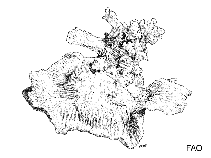Dipsastraea lacuna (Veron, Turak & DeVantier, 2000)
Upload your photos
Google image | No image available for this species;
drawing shows typical species in Merulinidae.
Google image | No image available for this species;
drawing shows typical species in Merulinidae.
Classification / Names Common names | Synonyms | CoL | ITIS | WoRMS
Anthozoa | Scleractinia | Merulinidae
Environment: milieu / climate zone / depth range / distribution range Ecology
Reef-associated; depth range 0 - 30 m (Ref. 848). Tropical; 30°N - 13°N, 32°E - 43°E (Ref. 848)
Distribution Countries | FAO areas | Ecosystems | Occurrences | Introductions
Western Indian Ocean: Red Sea.
Length at first maturity / Size / Weight / Age
Maturity: Lm ? range ? - ? cm
Short description Morphology
Colony: submassive to massive, often 1 m across. Corallites: subplocoid, circular to irregularly shaped, crowded; inner walls plunge vertically. Septa: thin, uniformly spaced and subequal, most reaching the columella deep within the calice. Costae of adjacent corallites do not meet, leaving a narrow ambulacral groove. Paliform lobes absent. Small and compact columellae. Color: tan with white centers (Ref. 848).
Found in shallow exposed reef environments (Ref. 848).
Life cycle and mating behavior Maturity | Reproduction | Spawning | Eggs | Fecundity | Larvae
Members of the class Anthozoa are either gonochoric or hermaphroditic. Mature gametes are shed into the coelenteron and spawned through the mouth. Life cycle: The zygote develops into a planktonic planula larva. Metamorphosis begins with early morphogenesis of tentacles, septa and pharynx before larval settlement on the aboral end.
Main reference
References | Coordinator | Collaborators
Veron, J.E.N. 2000. (Ref. 848)
IUCN Red List Status (Ref. 130435)
Near Threatened (NT) ; Date assessed: 01 January 2008
CITES status (Ref. 108899)
Appendix II: International trade monitored
CMS (Ref. 116361)
Not Evaluated
Threat to humans
Human uses
| FishSource |
Tools
More information
Internet sources
BHL | BOLD Systems | CISTI | DiscoverLife | FAO(Publication : search) | Fishipedia | GenBank (genome, nucleotide) | GloBI | Gomexsi | Google Books | Google Scholar | Google | PubMed | Hexacorallians of the World | Tree of Life | Wikipedia (Go, Search) | Zoological Record
Estimates based on models
Preferred temperature
(Ref. 115969): 24.8 - 29.3, mean 28.4 (based on 126 cells).
Price category
(Ref. 80766):
Unknown.



